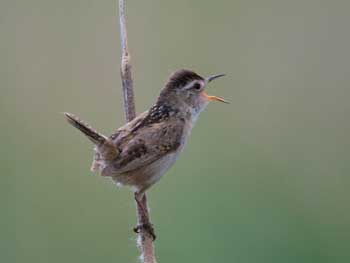 Marsh Wren (Cistothorus palustris)
Marsh Wren (Cistothorus palustris)
Note: Click on any image thumbnail to obtain a larger version.
Another note: This is a triathlon race report, but my wife Ellyn and I combined it with a birding and bird-photography trip for a couple of days. I got some nice bird photos, so I'll include them mixed with the race information, and you can ignore them or not, as you choose. If you're a birder, lured to this site by the bird names and are expecting a birding trip report, then sorry, you're out of luck.
 Marsh Wren (Cistothorus palustris)
Marsh Wren (Cistothorus palustris)
The half ironman is just one of a whole bunch of races at the same site that weekend, which includes a full and half marathon, an olympic-distance triathlon, a fun run for kids and "duathlons": just the bike and run portions of both the triathons listed above. All finish in the Sunriver resort that's a few miles south of Bend, Oregon.
My race was on Saturday, June 25, the same day as the half marathon, the marathon and the duathlon version of my half ironman. Ellyn and I left on Wednesday morning for the long drive to the Klamath Basin NWR where we arrived at about 3 pm, checked into a lodge, and went out for about 3 hours of birding and bird photography. Unfortunately for the photography, the light was pretty crappy. We spent the night there and birded/photographed for about six hours the next morning and then drove up to Sunriver, Oregon, arriving at about 5 pm.
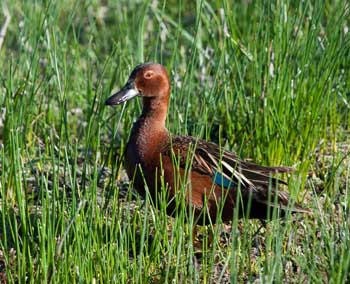 Cinnamon Teal (Anas cyanoptera)
Cinnamon Teal (Anas cyanoptera)
I had planned to drive the bike course on Saturday after registering, but we noticed on the map that by just going a few miles out of our way, we could drive the bike course and arrive at the resort via a slightly circuitous route, so we did that. It didn't look too bad: nothing very steep, but it's sometimes hard to tell when you're in a 250-horsepower car instead of using the 1/3 horsepower engine that comes with my bike. What did impress us was the amount of snow at the higher elevations (maybe that should have been a hint that there would be a lot of climbing). Below are a couple of photos that Ellyn snapped on her cell phone. We even saw a car stopped and people putting on cross-country skis at one point. At least the road was completely clear of snow, and it looked like the road surface was in pretty good condition. At the high point of the race course we were next to the Mount Bachelor ski resort and although I think it was closed, there still appeared to be enough snow that skiing there would not have been impossible.
Although the drive to the top seemed not to have any serious climbs, the descent looked like it would be amazing -- very, very fast, and for a long way -- which made me pretty sure that the power of the car had masked some serious climbs. It turns out that although there are three climbs that are "noticeable", you basically climb for 20 solid miles from about mile 20 to mile 40.
My coach Bruce had specified workouts (easy ones, since I was in a taper for the race), and although I'd done one extra swim workout earlier in the week, I missed all the ones specified for Wednesday, Thursday and Friday. But six hours of lugging around a very heavy tripod, lens and camera was at least a workout of sorts, although maybe not optimal. At least every night I was tired enough that I could easily go to sleep.
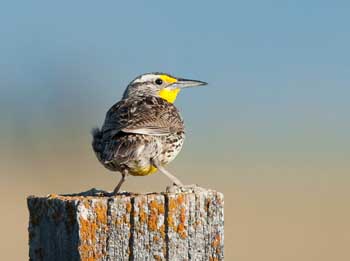 Western Meadowlark (Sturnella neglecta)
Western Meadowlark (Sturnella neglecta)
We decided to hang the expense on the first night and had dinner at the main restaurant in the lodge but it was very disappointing: bad service, high prices, and crappy food. I ordered the "lamb tenderloin", and it was about as far from "tender" as one could imagine. It was full of connective tissue and hard to cut, even with a steak knife. However, we did have much better luck at all of the less-fancy restaurants we tried during the rest of the stay.
At the Sunriver store we got some grapes, bananas, a turkey sandwich that I planned to eat on race morning, plus cereal, milk, and a bottle of wine. Since I've had trouble with cramps in races from time to time a current experiment I'm running on myself involves pickles and pickle juice, so we also bought a large pickle in a sealed plastic bag that I might eat on race morning.
The swim was in a lake called Wikiup Reservoir that's about 25 miles from the lodge, so the T1 transition (where you change from swim to bike) was there and it opened at noon on Friday. I registered early Friday and we were one of the first groups to arrive at the reservoir which was good. The bike racks were numbered in groups of 20 (race numbers 1-20 at the first, 21-40 at the second, et cetera), but there were no assigned spots on the racks, so I was able to set up on the very outside which is great. It's easy to get to the bike and there's more room to transition since I could use the space off the end of the rack rather than be between two rows of bikes. I registered for the race very early and consequently got a very low race number (25). The first 20 numbers were reserved for the "elite" athletes so I may have been the fifth person to register. On the bus ride to the start on Saturday I was seated next to a guy who had registered at the very last minute and there were only two race numbers larger than his, which gives my theory a bit more credence.
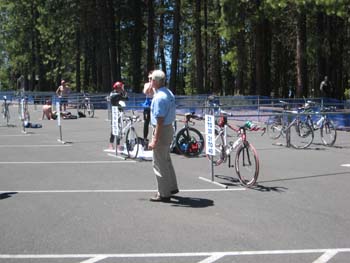
 On the left is a photo of me having just racked my bike on the outside. On the right, I'm testing the water temperature.
On the left is a photo of me having just racked my bike on the outside. On the right, I'm testing the water temperature.
In some races the numbers are used to define age groups but in this race it only told you how committed the racers were. We all had our ages written on one calf and our race number on the other, so if somebody passed you or you were trying to pass somebody, you could tell whether it was important or not, depending on the age number they had. Also, since on the same course at the same time there were both duathletes and relay teams, those people had different series of numbers: the relay folks were in the 1000's and the duathletes were in the 1500's. All the people in my race had numbers from 1 to 600.
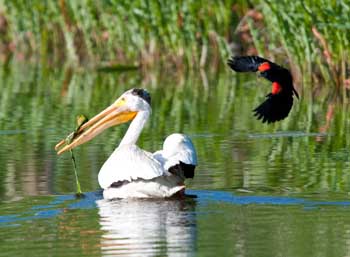 American White Pelican and Red-winged Blackbird (Pelecanus erythrorhynchos and Agelaius phoeniceus)
American White Pelican and Red-winged Blackbird (Pelecanus erythrorhynchos and Agelaius phoeniceus)
The race itself (at least from my point of view) went off without a hitch, but for some reason (and lots of the other folks we talked to agreed), the instructions were pretty bad. We had to read and reread and reread them often to figure out what to do. Instead of just a couple of pages, we had a 50-page booklet with information scattered throughout, and loaded with Sunriver ads. The maps were just official Sunriver maps with the courses drawn on top of them, so the numbers identifying various things had nothing to do with the race, but everything to do with helping a Sunriver guest find the spa or a restaurant. Roads unrelated to the resort had no name, so Ellyn and I had a fairly confusing drive out to the lake to set up my bike in T1 on Friday. We only had one minor mixup, but we drove for about 20 miles on a road without a single indication of its name or where it was headed. Ellyn had a GPS unit on her cell phone, and at least we could tell if the dot indicating our car was getting closer to or farther from Wickiup Reservoir.
For ten dollars I could have had my bike driven to the reservoir and set up on a rack for me and I could bring the rest of my stuff the next morning and do the final setup in T1 before the race, but I'm really glad I didn't, since I would not have gotten optimal positioning on the rack (probably) and I also wanted to take a look at the swim course. Since Wickiup Reservoir gets all its water from snow melt, and since our drive the previous day had demonstrated a lot of yet-to-be-melted snow, I was envisioning a path around the buoys created by an icebreaker, with penguins swimming along with us. Normally, the race description said, the water is about 65 degrees F, but this year is was 60. Not bad, especially compared to swimming in the ocean at Santa Cruz near home, but I wasn't sure I believed the 60. In any case, I stuck my hand in the water and maybe the 60 was true after all. A lot of folks had brought their wetsuits along for a test swim, but that's against my triathlon religion: I train only in warm pools and do open-water swims only for races. That strategy has worked out well for me so far...
One thing that was a little disturbing about the swim course (other than the penguins and polar bears) was that the buoys were almost invisible: tiny yellow things that were very hard for me to see, even standing on shore with my good glasses on. I'm very nearsighted, and I do have swim goggles that partly correct, but they're tinted, far from perfect, and in slightly choppy water and with my eyes only a few inches above it when I try to sight, I was a little worried about getting off course. And it wouldn't be the first time: I've got plenty of "extra credit" swimming in the various races I've done. (Hmmm ... maybe I should train in open water every now and then ...) Luckily, on race day, the tiny yellow markers had been replaced with the normal large orange buoys, and the yellow buoys had been moved to half-way points between the orange markers as sighting aids. In addition, although the swim start was almost directly into the sun, there were a couple of obvious tall trees in a perfect line with the first buoy so the sun was no problem.
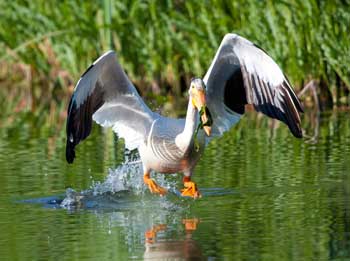 American White Pelican (Pelecanus erythrorhynchos)
American White Pelican (Pelecanus erythrorhynchos)
Of course I walked through the path from "swim out" to my bike a couple of times to make sure I wouldn't screw up after the swim with my brain in exhausted triathlete mode.
I did ask a few people who had gone swimming what they thought of the temperature and of course got completely mixed reviews, but at least most of them said it wasn't as bad as they'd feared. One theory was that the temperature had been significantly raised because every time a new person stepped into the icy water, he/she immediately peed in the wetsuit. It reminded me of a funny news story I'd read just a few days previous where at some reservoir in Oregon they'd caught a guy peeing into a drinking-water reservoir and had declared eight million gallons of water to be sewage and discarded it. Talk about over-reaction: first, urine is usually sterile, and second, hundreds of animals pee (and poop, which is not sterile) into the reservoir every day. On race day, although I, of course, would never dream of doing such a thing, I am positive that every other one of the 600 or so swimmers did pee in Wickiup Reservoir just before the race.
We then drove back to Sunriver and I walked over to T2 (the transition from bike to run) to set that up which involved putting down my shoes, running hat, running belt and a package with 4 electrolyte tablets by a spot on the rack where my bike would eventually go. I was early there, too, so got another prime spot. I decided not to leave my Garmin GPS watch at T2 since although most people are honest, it would sure be easy for somebody to walk away with it, so I knew I'd be running the half marathon "blind". It's not a big deal since I never look at the heart-rate data during a race anyway. I've got a pretty good idea how close I am to "red line" just by how bad I feel on a run. If I've got the GPS, I'll sometimes check it for mileage, but there were supposed to be mile markers every mile and the only thing I'd lose would be the post-race heart rate analysis.
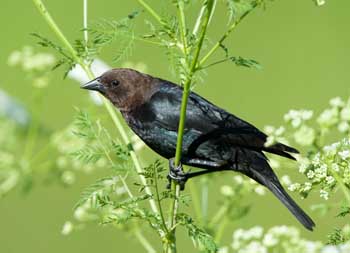 Brown-headed Cowbird (Molothrus ater)
Brown-headed Cowbird (Molothrus ater)
Another problem I've had is that I still don't ride my bike correctly, or at least "correctly" for triathlon -- I think I ride more like a bike racer (not as fast, but as inefficiently): I tend to ride out of the saddle too much (I get more power that way, but it's less efficient), and even when I'm seated, I tend not to spend as much time as I should in "aero" position since it's less comfortable. (I do a lot of cycling with friends, and it's sort of dangerous to ride close together in aero position since you can't control your bike as well with your hands farther from the brakes, and for other technical reasons, the bike is more unstable. In pure bike races where the riders are in groups, triathlon-style bikes are illegal for just those reasons.)
Also, in both my previous ironman races, I've fallen apart on the run in the sense that after 10 or 11 miles, I've started to walk more and more. If I can just keep running, I'll probably cut an hour off my final time. During those races I've never had to stop running, in the sense that if somebody had pointed a gun at my head, there was never a time when I couldn't have started running again, although it is so easy to think, 12 or 13 miles into the race, "I feel so dreadful now, and there are still 14 or 13 miles to go, and I'll never be able to keep running for the whole time." And once I start walking once, it's very easy to allow myself to do it again, and again, and again.
My race plan for both previous ironmans and for the upcoming one in Canada, is to walk through the aid stations (that come every mile) and start running again at the end of each station. My failure mechanism has been that at the end of aid station 10 or 11, I "allowed" myself to walk an extra 20 yards, then 30 yards at the next one, et cetera. My plan on this half ironman was to hammer very hard on the swim and bike to try to make sure I was pretty beat up when the half marathon started, and then to stick to my ironman strategy: walk the aid stations and run everything else, no matter how bad I felt.
 Forster's Tern (Sterna forsteri)
Forster's Tern (Sterna forsteri)
Another problem I have on the bike is that I tend to ride with a lower cadence than I should: again, more power required, but more comfortable for me. Coach Bruce says that one of the reasons my run isn't as good as it should be is that I hammer the legs too much by riding in too high a gear, so my goal was to try to keep the cadence in the 85-90 range instead of the 70-75 range that I tend to do when I'm not thinking about it.
In the past, in short races, I've had good luck with the strategy of, "Don't save anything for the next leg, and hope to find the strength to do it anyway." This isn't as stupid as it seems: you use different sets of muscles during the three parts, and there's some time in transition that allows for a bit of recovery. Deciding to do it on a half ironman is a little more frightening than for an olympic-distance triathlon (1500 meters swim, 40 kilometers bike and 10 kilometers run), but I had recently heard a couple of good triathletes from my club talking about how they do ironmans, and both basically said that they're exercising at just below "red line" for the whole race. I figured I'd try that for the half ironman and see what happened.
There is a lot of good information at www.athlinks.com. Here are my results, for example.
 Lesser Scaup (Aythya affinis)
Lesser Scaup (Aythya affinis)
Anyway, I checked out what I could and figured out that I'd have a pretty good chance of winning although one of the competitors had some times on shorter races that were comparable with mine. Of course my previous experience is that I'm relatively better at shorter races (I am trying to change that), but if it's true, being better at a short distance than somebody doesn't mean I'd be better at this longer distance. In any case, I decided I'd try to win. (Of course that's what I always try to do, as stupid as it may be.)
For ten dollars I bought a bus ticket from Sunriver (a ten-minute walk from the lodge) to the start at 7:00 am on race day. I met a nice guy on the ride who was doing his first half ironman. I didn't know any of the racers, so I hung around with him a bit at the start and offered some advice, which may or may not have been helpful: I did not see him at the finish, although it couldn't have been too bad advice, since I did check at the end to make sure he had finished, and he had.
I tried a bite of the pickle in the morning to ward off cramps, but it turned out to be highly spiced and I decided not to take that sort of chance. I did eat the turkey and swiss cheese sandwich as soon as I got to the starting area, a bit more than two hours before I started to race. Twenty minutes before my start time I also ate an energy bar.
It was pretty cold at the start and in addition to my fleece jacket and warmup pants, I sort of wished I had a stocking cap, but since the race started when the sun was fully up (the first heat left at 9:00 am), it did warm up a bit. I put on my wetsuit at about 8:30 and got in the water to see just how cold it was and to swim a few hundred yards to warm up. The water wasn't bad at all, and since the race started from one boat ramp and ended on an adjacent one, I tried doing a practice water exit on the correct ramp and discovered that it was a very rough surface and not at all pleasant to walk on. Well, at least I knew what was coming, and I hoped that my feet would be so numb at the end of the swim that I wouldn't notice the roughness.
Early in the morning it was so cold that I worried a bit about starting off on the bike, soaking wet in the cold. But I realized that there wasn't much to be done; the only thing I could change would be to put on some arm warmers that I'd worn in the morning to stay warm, but I didn't want to waste the time, and didn't think it would help much anyway. So I figured I'd just strip off the wetsuit, hop on the bike, and see if I got hypothermia. I also knew the weather report, and it was for a nice day, so I was really pretty sure I'd be fine.
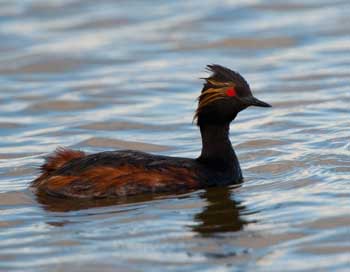 Eared Grebe (Podiceps nigricollis)
Eared Grebe (Podiceps nigricollis)
The race started in six heats, mine being the last one that included everybody of age 45 or more, starting at 9:20. Another thing that I knew but didn't consider too important until near the middle of the race was that the duathletes (who were skipping the swim) started off at 15-second intervals beginning at 9:00 am on their bikes.
As usual, I got to the front line of the swimmers and got one of the cleanest starts I've ever had: no body contact at all, and within 20 strokes, I could clearly sight on the trees over the first buoy, there was nobody directly in front of me (but people on the sides a bit ahead and a bit behind: I was not the fastest swimmer in the group). In fact, the only (very minor) interference I encountered was when we started to catch people in the waves in front of us. The waves were designated by different-colored caps, so it was clear when I started to catch the slowpokes in each successive group.
I felt like I was going very solidly, and I had no problems with sighting, especially after the first turn when I wasn't looking directly into the sun. I had no idea what my time was, but I figured it was around 30-34 minutes. (I never trust buoy placement in triathlons, since it's tough to do accurate water measurements. I always hope that the actual distance is longer than advertised, since I'm best at the swim.) In any case, my feet were so numb that I didn't notice the exit ramp, I got the wetsuit off quickly, and got going on my bike with no problems. Last year I sliced about 2 inches off the bottom of the legs of the wetsuit and that sure makes it a lot easier to remove in T1.
Since I'm a relatively fast swimmer, I know that immediately after getting out of the water, I'm almost always passed by a bunch of folks who are strong cyclists and weak swimmers. This certainly occurred, but with our ages on our calves, all I really cared about was that I not be passed (or at least that I keep track) of all the folks who passed me in my age group. I didn't know, of course, if there were people in my age group who were faster swimmers, but I suspected not.
On the bike course I discovered that there was a lot more climbing than I'd thought there was when we drove the course on Thursday. In fact, I think it's one of the hilliest I've done in a triathlon (per mile -- there was nothing that was particularly steep). But basically there were about 20 miles of almost solid climbing to the highest point. It was usually not too steep except for in about three sections to be in aero position, but due to my bad habits, I kept finding myself wanting to stand up or at least to sit up. My back got pretty tired, and at least once every couple of miles I did stand up to give my back a stretch, but I kept imagining that coach Bruce was with me and that he'd want me to get back down after at most three or four pedal strokes. I tried to think about what Bruce would think about my cadence at any point of the ride, and consequently, I found myself shifting down a fair amount. (You can see how I did in this section -- I'm actually quite pleased with how high my cadence was.)
I was riding pretty hard, and keeping an eagle-eye on the numbers on the calves of my competitors. I never saw anybody in my age group on the bike, but I was passed by a 66 year old guy. He and I played leapfrog for much of the bike course. I wanted to beat him (since I'm 62 and didn't want to be beaten by an "old geezer") but since he wasn't in my age group, it wasn't the most important thing in the world for me. In fact, when I got to T2, I wasn't even positive who was ahead in our game of leapfrog.
In retrospect, the only error I made on the bike course was that I wasn't carrying enough food. I ate both the gels and drank all the Perpetuem by about the 40 mile mark (out of 58 -- due to technical traffic issues in Sunriver it made good sense to add a couple of miles to the course). My plan had been to take on only water at the three aid stations, but since I was out of sugary fuel I picked up a bottle of Gleukos instead of water at the final bike aid station.
I had one weird experience on one of the steepest part of the climb when I put on a little power surge to pass somebody and got a very sharp pain in the muscle on the side of my right knee. It continued to hurt for about a minute and finally disappeared, but I had this nagging fear that it would recur, maybe during the run. It didn't, and I don't have any idea what it was.
I also swallowed four of the six Salt Stick electrolyte capsules at about 10 mile intervals during the ride to try to avoid cramps.
From the top of the final climb, there was a rip-roaring descent for the first bit (I averaged over 40 mph = 64 kph on one of the early miles). I was going so fast that when I turned my head sideways the air vents in my helmet turned into quite loud whistles. I discovered that I didn't know how to open the Gleukos bottle which I had picked up very near the top, and decided to wait until the slope decreased so as not to kill myself trying to get the bottle open. It turns out that you have to twist the top, and I'd never tried to do that with my teeth, especially at high speed. After the race I was talking to a gal who had also just finished, and I mentioned how much I enjoyed the descent. She said that on the way down, after all the climbing, she kept telling herself, "We SO deserve this!"
I got to T2, had a fairly good transition, and waddled off on the run. For the first couple of hundred yards I probably looked like I was suffering from some bizarre neurological condition, but after I warmed up, it wasn't so bad. I remember running next to a guy as we passed the "1 mile" sign and told him, "One down, 12 to go!" but then another "1 mile" sign came up and I realized that the course was shared for the triathlon and the half and full marathons and with different starting points, the mileages didn't exactly match up. Unfortunately, it was not quite a mile, but at least I knew to look for the mile signs for the triathlon/duathlon.
Since I had gotten in the full bottle of Gleukos near the end of the ride, I started the run taking on only water, but after about two miles, my right calf started threatening to cramp, so I swallowed a couple of Salt Stick electrolyte capsules I was carrying. The cramping threats continued and so just before the mile 4 aid station I put the last two tablets I had into my mouth and crushed them with my teeth before washing down the mess with the aid station water. That seemed to work and I had no more cramping problems after about mile 5.
 Tri-colored Blackbird (Agelaius tricolor)
Tri-colored Blackbird (Agelaius tricolor)
I didn't see anybody in my age group, so I started trying to keep up with a 42-year-old gal who seemed to be running at about my speed. We'd leapfrog again and again, and finally I thought I'd "put her away" at about mile 4, but suddenly at about mile 5.5 she passed, started gaining, and I couldn't catch her. I just kept going, trying to keep a solid pace, and caught her again at about mile 7, at which point I passed her and never saw her again. I looked her up at the end, and she finished only a minute or so behind me.
I was very tired, and started having the same thoughts about walking beyond the end of the aid stations, but never did. On the other hand, it was only a half marathon, so I only had to hang on for 13 aid stations. We'll see if I can continue that mental discipline at IM Canada...
I started playing a new game for the last six miles: hardly anybody was passing me, and I starting catching lots of the duathletes, all of whom had started between 20 and 50 minutes before I did. They were easy to identify by their race numbers. The game I played was that each time I saw one of them ahead, I pretended that they were the last guy in my age group that I needed to catch to win the race, and that made each chase a bit more interesting.
At the seven-mile mark I converted the rest of the race, mentally, into kilometers, since although there were 10 of them, they came by a lot faster, and I could see progress. I still only got to walk at the mile markers, however. The last mile went pretty well, and I went into it knowing that all estimates by spectators were suspect, but of course when somebody yells, "It's only 100 yards!" I still wanted to believe it, although I was virtually certain they had underestimated the distance. Finally the end came and I was pretty happy to see it.
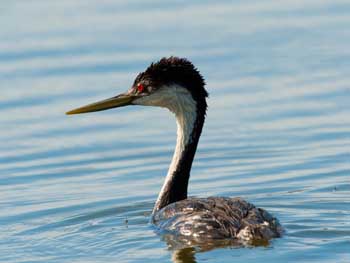 Western Grebe (Aechmophorus occidentalis)
Western Grebe (Aechmophorus occidentalis)
I felt pretty beat-up at the end: maybe as beat-up as I do at the end of most marathons and maybe slightly worse than I did at the end of the two ironmans I've done in the past, but I really pushed myself on the run. The final results were, however, great: I won my age group, and not just by a little. I beat the second-place guy by more than an hour! I also wondered about the 66 year old: at the awards banquet a 66 year old won, but with a time about a half hour slower than mine, although I was certain his swim+bike was about the same as mine. I thought that perhaps somebody had a misleading number on his calf to fool competitors, but looking at the final results, I did, in fact, run the half marathon about 30 minutes faster than he did.
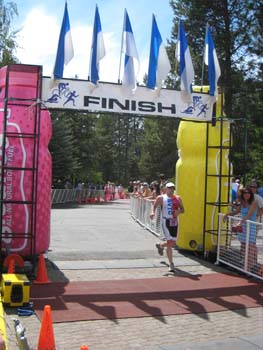 Here I am, at the finish!
Here I am, at the finish!
Here are my final splits:
Total: 5:47:32
Swim: 0:32:34
T1: 3:03
Bike: 3:10:02
T2: 2:10
Run: 1:59:43
Out of all the 500-odd racers, I was number 50 on the swim, 192 on the bike, and 166 on the run. It's the third race in a row where my run has been relatively better than the bike.
Also, note that the x-axis is time, not distance, so the descent at the end is not nearly as steep as it may appear from the graphs below.
Bike Course Race Data
Below is the race data collected from the Garmin device on my bike. The total time is different from my official time because I turned off the computer when I hit the dismount line, not when I entered transition, and I had to jog with the bike for a couple of hundred meters between dismount and T2.